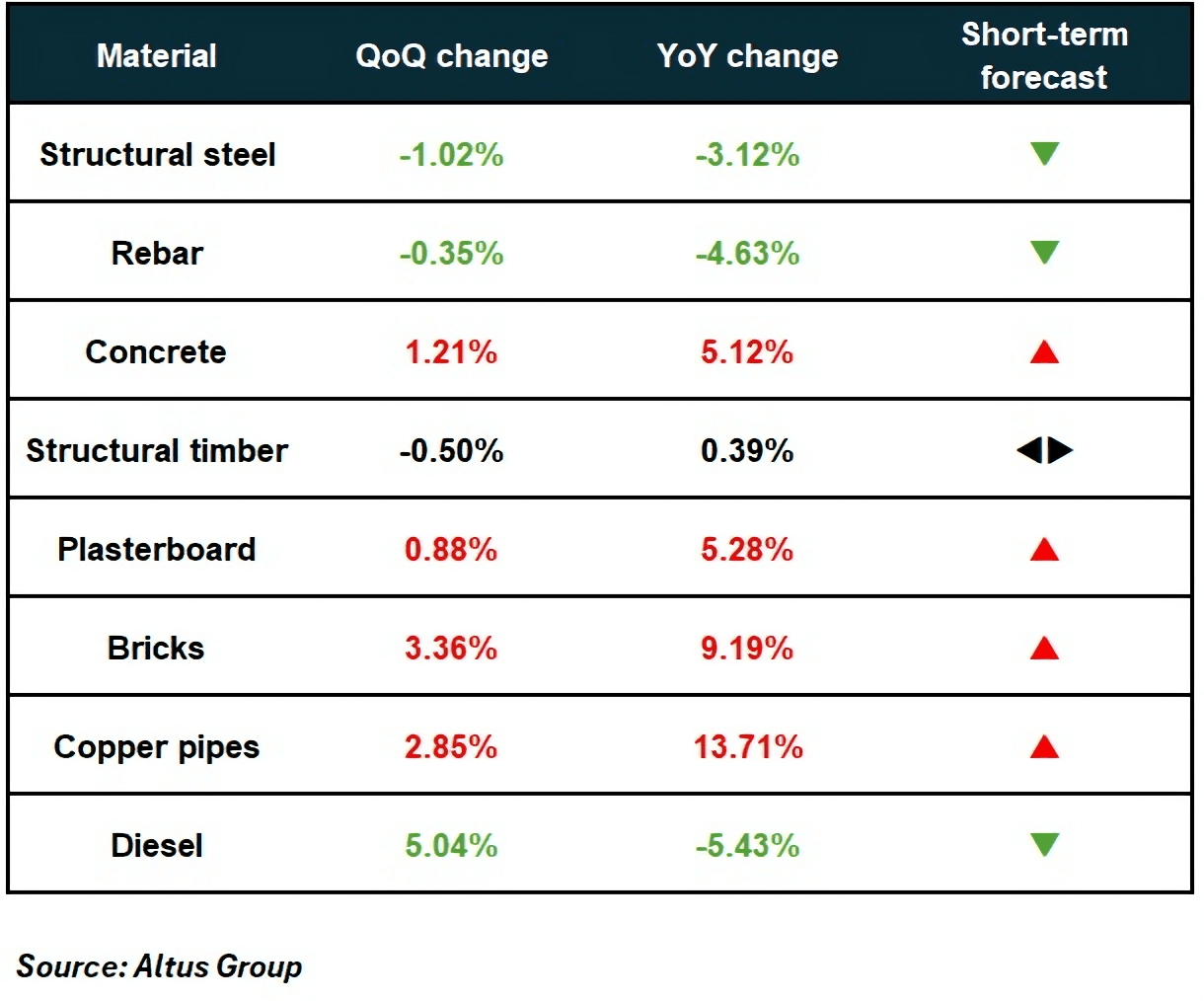Australian construction price outlook – Q1 2025
Our market intelligence and robust data provide quarterly Australian material price indicators for the construction sector.

Key highlights
Global trade turbulence meets local cost pressures, with tariffs creating uncertainty and the Australian dollar’s depreciation driving up the cost of critical materials
Labour costs and productivity remain critical pain points, putting pressure on feasibilities and national housing targets
Insolvencies and industrial risks are rising, with construction businesses failing at record rates
Overview
“Uncertainty” is the defining theme for the quarter for a construction sector caught between two powerful forces: volatile global trade dynamics and a domestic market struggling with persistent productivity problems and stubborn labour costs.
The word “uncertain” appeared eight times Reserve Bank Governor Michele Bullock’s statement announcing the decision to cut the cash rate by 25 basis points to 3.85% following its 20 May meeting.
While inflation, continues to ease and is now within the RBA’s target range, the overall outlook is unclear. The Trump administration’s new transactional approach to trade, including US-imposed tariffs and policy responses from other countries, could have an adverse effect on global economic activity, stifling investment, confidence and growth.
Tariffs disrupt supply chains which can destabilise construction projects, drive up costs and reshape development strategies. In the US, shipment volumes from China fell by as much as 40% following the Trump administration’s 145% tariff on Chinese imports.
While US and China now pause to negotiate, the Australian dollar has weakened, pushing up the cost of imported materials. The broader economic implications are clear. The International Monetary Fund has downgraded Australia's GDP growth forecast for 2025 from 2.1% to 1.6%, citing global trade tensions.
Against this backdrop, material prices offer a mixed outlook. Steel and copper prices have eased, but energy-intensive materials like concrete and bricks remain costly. Meanwhile, China is still looking to alternate markets for products, which may see cheap, lower-quality products, like steel, flood Australia’s market.
While geopolitics may be uncertain, the re-election of the Albanese Government with an increased majority in May 2025 offers some local political stability. The second-term government plans to diversify trade partnerships and invest in sectors like critical minerals and renewable energy.
For the built environment sector, there will be few policy surprises. Advocacy groups have been working with the federal government for three years, and have already signalled their focus areas for the next term of government. And a lack of meaningful opposition will likely mean a third term for the Australian Labor Party.
The Property Council of Australia’s priorities are planning and red tape. The Green Building Council of Australia is focused on strengthening the National Construction Code and introducing mandatory disclosure for residential energy performance. Engineers Australia wants a “National Chief Engineer” and 60,000 extra engineering graduates over the decade, while the Australian Constructors Association is focused on productivity uplifts through the National Construction Strategy Industry Forum.
Industrial relations is likely to remain a point of tension, with the demise of the CFMEU leaving a power vacuum and the risk of renewed industrial disputes.
Labour productivity in residential construction has declined by 12% since 1995, even after accounting for quality improvements and larger housing sizes. In contrast, the broader economy’s productivity has grown by 49% over the same period. The result is a widening gap between input costs and output – a direct threat to profitability.
Construction companies continue to face record insolvencies, with ASIC data revealing 3,948 businesses entering administration between April 2024 and April 2025. The collapse of Roberts Co’s Victorian division, leaving 100-plus trade creditors owed approximately $50 million, underscores the sector’s financial strain. Roberts Co’s NSW operation was subsequently sold to UAE-based developer Arada in May.
For many builders, the challenge is not just finding workers – it is finding workers they can afford. Infrastructure Australia’s latest Market Capacity Report reveals a national shortfall of 197,000 infrastructure workers. Even skilled migration offers limited relief, as Australia’s housing shortage makes it difficult to accommodate incoming talent.
Survival means looking past the headlines to understand the real drivers of cost and risk.
Outlook on construction cost escalation
Altus Group combines our market intelligence with a range of reliable and robust data sources, including those from the Australian Bureau of Statistics and the Australian Institute of Quantity Surveyors, to provide national price indicators. These prices are subject to market movements.
| Figure 1 – Altus Group’s outlook on construction cost escalation
Sydney | Brisbane | Melbourne | Perth | |
|---|---|---|---|---|
2019 | 4.0% | 3.0% | 3.5% | 2.5% |
2020 | 3.5% | 2.5% | 3.75% | 3.75% |
2021 | 4.5% | 3.25% | 4.0% | 7.25% |
2022 | 7.5% | 8.5% | 7.5% | 7.5% |
2023 | 5.9% | 9.25% | 6.25% | 6.75% |
2024 | 5.50% | 7.50% | 4.75% | 5.50% |
2025 | 4.50% | 7.00% | 4.50% | 5.75% |
2026 (previous forecast) | 4.75% (4.75%) | 6.75% (6.50%) | 4.50% (4.75%) | 5.25% (5.00%) |
2027 (previous forecast) | 4.75% (4.75%) | 6.25% (6.00%) | 4.25% (4.50%) | 4.75% (4.50%) |
Note: These figures are general, and individual projects and asset classes may have dramatically different spreads of costs. Previous forecasts were made in December 2024.
Source: Altus Group
Material Price Snapshot
Escalation rates remain highly variable, depending on project type, size, location and materials. Given these complexities, it is essential to consult professional quantity surveyors to evaluate project-specific costs and escalation factors and receive tailored assessments for accurate forecasting and risk management.
Figure 2 – A snapshot of Australian construction material price trends – Q1 2025

| Figure 3 – Altus Materials Escalation Index (Australia)
Altus Materials Escalation Index (Australia)
Download
Source: Altus Group
Material price movements
Structural steel and rebar: The ongoing price decline in steel and rebar reflect weakened demand, especially in China, where domestic activity remains sluggish. With no significant recovery in demand forecast, steel prices are expected to remain subdued.
Concrete: Rising concrete prices reflect the material’s energy-intensive production process amid energy cost rises, combined with global pressures to decarbonise. The World Cement Association forecasts global cement demand to fall to 3 billion tonnes per annum by 2050, and clinker demand to fall to 1.5 billion tonnes annually. Softening demand in the near-term suggests prices may stabilise.
Structural Timber: Australia’s housing construction slowdown and high inventory levels have kept timber prices relatively stable, with minimal volatility anticipated. However, a report commissioned by the Australian Climate and Biodiversity Foundation has found Australia’s hardwood production has fallen by more than 80% since 2000, and new plantations have stalled since 2010, limiting material essential for construction and Australia’s housing targets.
Plasterboard: Plasterboard prices have levelled off this quarter after a significant increase over the year. With demand remaining weak, no further price hikes are anticipated.
Bricks: Prices increased this quarter and annually. Brick manufacturing cost hikes have been driven by surging energy costs – as brick kilns are reliant on natural gas – and transport costs. Brick production is labour-intensive, adding costs to production.
Copper: Demand for copper remains strong, particularly for electrical equipment, wiring and electric vehicle manufacturing. The global energy transition and growth in data centres are driving copper consumption.
Diesel: Diesel prices have fallen to pre-pandemic levels, offering some transportation and logistics cost relief. Global crude oil prices have reached a four-year low as increased production by major oil producers intersects with falling demand.
Macro-economic review
Consumer Price Index
| Figure 4 – All groups CPI, Australia, quarterly and annual movement (%)
All Groups CPI Australia
Quarterly and annual movement (%)
Download
Source: Australian Bureau of Statistics | Altus Group
Australia’s Consumer Price Index (CPI) rose by 0.9% over the March 2025 quarter, bringing annual inflation to 2.4 – well within the Reserve Bank’s 2–3% target range. The main contributors to the quarterly rise were housing (+1.7%) and education (+5.2%) due to seasonal fee increases. Electricity prices surged by 16.3% over the quarter, contributing to inflationary pressure.
Producer Price Indices – Input
| Figure 5 – Producer Price Indexes (PPI) – Input, Australia
Producer Prices Indexes (PPI) - Input, Australia
Download
Source: Australian Bureau of Statistics | Altus Group
Prices for building materials used in residential construction recorded the first quarterly price decrease since the March 2012 quarter. This fall was driven by discounting across key products, particularly timber and steel, reflecting lower demand in competitive markets of New South Wales and Victoria. Most building material prices were stable this quarter due to easing input cost growth and softening demand. Over the past 12 months, input prices for house construction have risen by 1.1%.
Producer Price Indices – Output
| Figure 6 – Producer Price Indexes (PPI) – Output, Australia
Producer Prices Indexes (PPI) - Output, Australia
Download
Source: Australian Bureau of Statistics | Altus Group
Price growth in building construction output was driven by sustained labour costs, but at a slower pace as labour shortages eased and enterprise bargaining agreements stabilised. Strong demand for concrete trades and electrical services kept upward pressure on prices. Non-residential activity and infrastructure projects intensified competition for limited resources, including labour and concrete, sustaining high price levels. However, quarterly price increases have steadily declined since December 2023.
Wage Price Index
| Figure 7 – Wage Price Index (WPI), Australia
Wage Price Index (WPI), Australia
Download
Source: Australian Bureau of Statistics | Altus Group
The seasonally adjusted Wage Price Index (WPI) for the construction industry grew by 0.7% in the December 2024 quarter and 3.4% for the year. This was lower than the national quarterly average of 3.2% annual growth. Persistent wage pressures have been a significant contributor to the rise in the Construction Producer Price Index for output, further exacerbating overall cost increases. Skilled labour shortages and unionised workforces increase project costs and impact builders’ profit margins.
Building approvals
| Figure 8 – Building approvals, Australia
Building Approvals
Download
Source: Australian Bureau of Statistics | Altus Group
Total dwelling approvals in Australia fell by 0.3% in February 2025 to 16,606. Private sector house approvals rose by 1.0% to 9,203, while multi-unit dwellings declined by 1.5% to 7,113. Industry experts have noted that the high costs of construction and financing are making it difficult for developers to proceed with multi-unit projects.
Despite the slight drop in overall approvals, the value of total residential building rose 5.0% to $9.65 billion, suggesting a combination of rising construction costs and a shift toward higher-value projects. In contrast, non-residential building approvals plunged 16.5% to $4.69 billion, reflecting a slowdown in commercial developments amid broader economic uncertainty.
The trend estimate for the value of total building work approved rose by 0.3% in February 2025, to $15 billion, following a 0.9% rise in January. The value of total residential building increased by 2.3% to $9.35 billion, while non-residential building approvals fell by 2.7% to $5.65 billion.
| Figure 9 – Total dwellings completed, Australia
Total Dwellings Completed
Download
Source: Australian Bureau of Statistics | Altus Group
The number of dwellings completed has stabilised to around 15,000 per month over the past 12 months, aligning closely with approval numbers. This current pace falls significantly short of the National Housing Accord’s target of constructing 1.2 million new homes over five years. The State of the Housing System report, published in May, finds the net new supply is expected to total 825,000 over the Housing Accord period – 79,000 dwellings fewer than expected new underlying demand.
Summary
The construction sector isn’t just dealing with cost pressures. It is wrestling with a productivity problem that won’t go away. Material prices may shift, but the real threat is deeper: a workforce stretched thin, a three-decade productivity flatline and a volatile industrial landscape. Rising wages and record insolvencies only add to the strain.
Success demands discipline and precision. Builders must look beyond the headlines to understand the true drivers of cost, maintain strong supplier relationships and navigate industrial risks with a clear strategy.
In a market defined by constant uncertainty, resilience isn’t just about weathering the storm – it’s about navigating the unknown.
Methodology
Market research into the supply cost of core materials is conducted on a quarterly basis with manufacturers and suppliers. Our market assessment also involves a thorough analysis of secondary sources of market data on materials and labour prices.
These sources include the Australian Bureau of Statistics (ABS), the Australian Institute of Quantity Surveyors (AIQS), Fuel Price Index, Metal and Raw Material Price, and proprietary cost data from Altus Group.
Disclaimer
This publication has been prepared for general guidance on matters of interest only and does not constitute professional advice or services of Altus Group, its affiliates and its related entities (collectively “Altus Group”). You should not act upon the information contained in this publication without obtaining specific professional advice.
No representation or warranty (express or implied) is given as to the accuracy, completeness or reliability of the information contained in this publication, or the suitability of the information for a particular purpose. To the extent permitted by law, Altus Group does not accept or assume any liability, responsibility or duty of care for any consequences of you or anyone else acting, or refraining to act, in reliance on the information contained in this publication or for any decision based on it.
The distribution of this publication to you does not create, extend or revive a client relationship between Altus Group and you or any other person or entity. This publication, or any part thereof, may not be reproduced or distributed in any form for any purpose without the express written consent of Altus Group.
Want to be notified of our new and relevant CRE content, articles and events?
Authors

Niall McSweeney
Head of Development Advisory, Asia-Pacific

Cody Bui
Quantity Surveyor
Authors

Niall McSweeney
Head of Development Advisory, Asia-Pacific

Cody Bui
Quantity Surveyor
Resources
Latest insights





Jan 9, 2025
Building the future - Key trends shaping Australia’s construction industry in 2025

